warning KIA Optima 2006 2.G Manual PDF
[x] Cancel search | Manufacturer: KIA, Model Year: 2006, Model line: Optima, Model: KIA Optima 2006 2.GPages: 225, PDF Size: 3.77 MB
Page 144 of 225
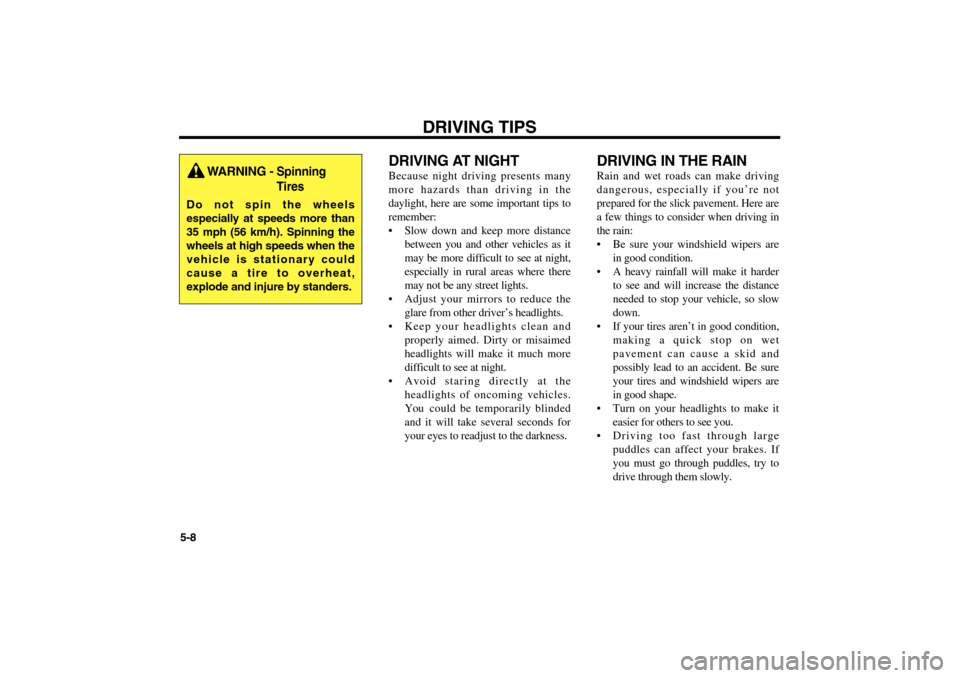
DRIVING TIPS
5-8
DRIVING AT NIGHTBecause night driving presents many
more hazards than driving in the
daylight, here are some important tips to
remember:
Slow down and keep more distance
between you and other vehicles as it
may be more difficult to see at night,
especially in rural areas where there
may not be any street lights.
Adjust your mirrors to reduce the
glare from other driver’s headlights.
Keep your headlights clean and
properly aimed. Dirty or misaimed
headlights will make it much more
difficult to see at night.
Avoid staring directly at the
headlights of oncoming vehicles.
You could be temporarily blinded
and it will take several seconds for
your eyes to readjust to the darkness.
DRIVING IN THE RAINRain and wet roads can make driving
dangerous, especially if you’re not
prepared for the slick pavement. Here are
a few things to consider when driving in
the rain:
Be sure your windshield wipers are
in good condition.
A heavy rainfall will make it harder
to see and will increase the distance
needed to stop your vehicle, so slow
down.
If your tires aren’t in good condition,
making a quick stop on wet
pavement can cause a skid and
possibly lead to an accident. Be sure
your tires and windshield wipers are
in good shape.
Turn on your headlights to make it
easier for others to see you.
Driving too fast through large
puddles can affect your brakes. If
you must go through puddles, try to
drive through them slowly.
WARNING -
Spinning
Tires
Do not spin the wheels
especially at speeds more than
35 mph (56 km/h). Spinning the
wheels at high speeds when the
vehicle is stationary could
cause a tire to overheat,
explode and injure by standers.
MS-CNA-Eng 5 New.qxd 7/25/2005 5:21 PM Page 8
Page 145 of 225

5-9
If you believe you may have gottenyour brakes wet, apply them lightly
while driving until normal braking
operation returns.WINTER DRIVING We recommend that you carryemergency equipment. Some things
you might include are tire chains, a
window scraper, windshield de-icer,
a bag of sand or salt, flares, a small
shovel and jumper cables.
Make sure you have sufficient ethylene glycol coolant in the
radiator.
Check the battery condition and cables. Cold temperatures reduce the
capacity of any battery, so it must be
in top shape to provide enough
winter starting power.
Make sure the engine oil viscosity is suitable for cold weather.
Check the ignition system for loose connections and damage. Use antifreeze-formulated windshield
washer fluid and make sure you have
sufficient fluid for your trip. (Do not
use engine coolant antifreeze.)
Do not use the parking brake if it might freeze. This is most likely to
happen after driving in slushy or wet
conditions and temperatures drop into
the freezing range. When parking,
shift to P (Park) with automatic
transaxle, or to 1 (First) or R
(Reverse) with a manual transaxle
and block the rear wheels.
SNOW TIRESWhen snow tires are used, select the size
and construction specified on the Tire
Pressure Label. It is strongly
recommended that snow tires be used on
all four wheels, or poor handling may
result. Snow tires should not be operated
at speeds exceeding 120 km/h (75 mph).
These tires should be inflated 4 psi (28
kPa, 0.3 kg/cm
2) above the recommended pressures shown on the Tire
Specification/Pressure Label, but inflation
should never exceed the maximum cold-
tire pressure shown on the tire sidewalls.
Do not install studded tires without first
checking local, provincial and municipal
regulations for possible restrictions
against their use.
WARNING - Snow Tire
Size
Snow tires should be
equivalent in size and type to
the vehicle’s standard tires.
Otherwise, the safety and
handling of your vehicle may be
adversely affected.
MS-CNA-Eng 5 New.qxd 7/25/2005 5:21 PM Page 9
Page 146 of 225

DRIVING TIPS
5-10TIRE CHAINSTire Chain SelectionRegulations regarding the use of tire
chains vary according to location or type
of road, so always check them before
installing chains.
Use only SAE Class “S” tire chains.
Chains must be the proper size for the
vehicle, as recommended by the chain
manufacturer.CHAIN INSTALLATIONWhen installing chains on your tires,
carefully follow the instructions of the
chain manufacturer.
The chain bands will scratch the wheel
covers. Remove the covers before
installing the chains.Install the chains on the front tires as
tightly as possible. The use of chains on
the rear tires is not recommended.
Retighten the chains after driving 0.5-1.0
km (1/4-1/2 mile).
Driving in Flooded AreasAvoid driving through flooded areas
unless you are sure the water is no higher
than the bottom of the wheel rims. Drive
through any water slowly. Allow
adequate stopping distance because
brake performance may be affected.
After driving through water, dry the
brakes by gently applying them several
times while the vehicle is moving slowly.
WARNING - Tire Chains
The use of chains may
adversely affect vehicle
handling.
Do not exceed 30 mph (50 km/
h) or the chain manufacturer’s
recommended speed limit,
whichever is lower.
Drive carefully and avoid
bumps, holes, sharp turns
and other road hazards,
which may cause the vehicle
to bounce.
Avoid sharp turns or locked
wheel braking.
Do not attempt to use a tire
chain on the temporary spare
tire because it may impair
vehicle handling and result in
damage to the vehicle and the
tire.
MS-CNA-Eng 5 New.qxd 7/25/2005 5:21 PM Page 10
Page 149 of 225

5-13
ProgrammingYour vehicles may require the ignition
switch to be turned to the "ACC"
position for programming and/or
operation of HomeLink. It is also
recommended that a new battery be
replaced in the hand-held transmitter of
the device being programmed to
HomeLink for quicker training and
accurate transmission of the radio-
frequency.
Follow these steps to train your
HomeLink mirror:1. When programming the buttons for
the first time, press and hold the two
outside HomeLink buttons ( ,
), releasing when the
indicator light begins to flash
(approximately 20 seconds). This
procedure erases the factory-set
default codes. Do not perform this
step when programming additional
transmitters.
MMSA5005
WARNING
Do not use HomeLink with any
garage door opener that lacks
the safety stop and reverse
feature as required by federal
safety standards (includes
garage doors manufactured
before April 1, 1982), as these
doors can increase the risk of
serious injury or death. Call
1.800.355.3515 or visit
www.homelink.com for more
information.
Flashing
MS-CNA-Eng 5 New.qxd 7/25/2005 5:21 PM Page 13
Page 152 of 225
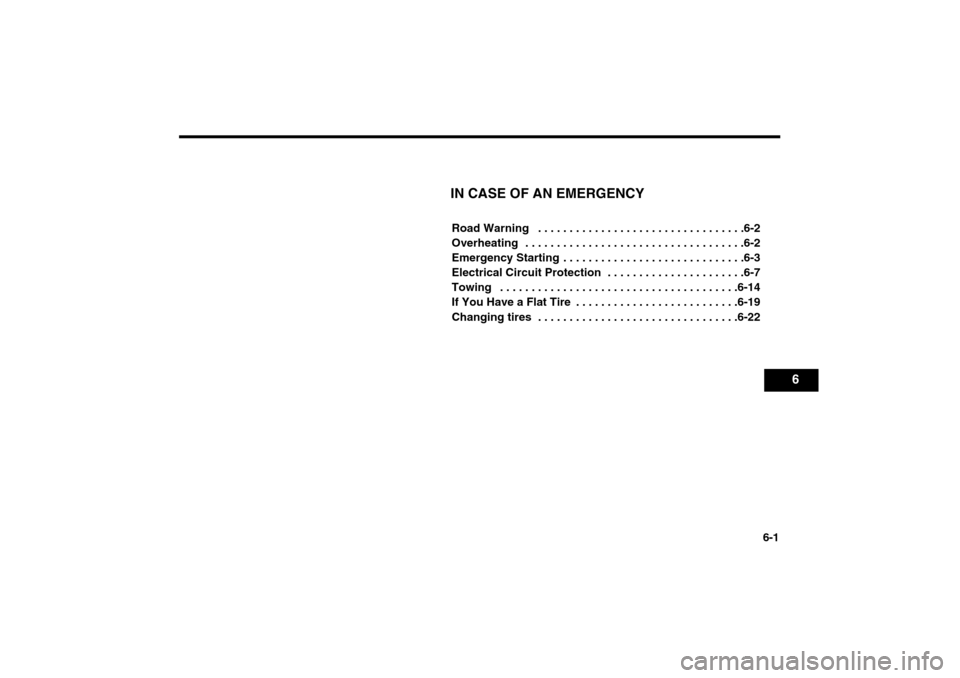
6-1
IN CASE OF AN EMERGENCYRoad Warning . . . . . . . . . . . . . . . . . . . . . . . . . . . . . . . . .6-2
Overheating . . . . . . . . . . . . . . . . . . . . . . . . . . . . . . . . . . .6-2
Emergency Starting . . . . . . . . . . . . . . . . . . . . . . . . . . . . .6-3
Electrical Circuit Protection . . . . . . . . . . . . . . . . . . . . . .6-7
Towing . . . . . . . . . . . . . . . . . . . . . . . . . . . . . . . . . . . . . .6-14
If You Have a Flat Tire . . . . . . . . . . . . . . . . . . . . . . . . . .6-19
Changing tires . . . . . . . . . . . . . . . . . . . . . . . . . . . . . . . .6-22
6
MS-CNA-Eng 6.QXD 7/25/2005 5:13 PM Page 1
Page 153 of 225

ROAD WARNINGHAZARD WARNING FLASHERThe hazard warning flasher serves as a
warning to other drivers to exercise
extreme caution when approaching,
overtaking, or passing your vehicle. It
should be used whenever emergency
repairs are being made or when the vehicle
is stopped near the edge of a roadway.Depress the flasher switch with the
ignition switch in any position.
All turn signal lights will flash
simultaneously.
• The hazard warning flasher will
operate whether your vehicle is
running or not.
The turn signals do not operate when
the hazard flasher is on.
Care must be taken when using the
hazard warning flasher while the
vehicle is being towed. Local
regulations may prohibit using it in
this manner.
OVERHEATINGIf your temperature gauge indicates
overheating, if you experience a loss of
power, or if you hear a loud knocking or
pinging noise, the engine has probably
overheated. You should follow these
procedures if you experience any of
these symptoms.
1. Turn the hazard warning flasher on,
then drive to the nearest safe location
and stop your vehicle; set the
automatic transaxle in P (Park), or
shift the manual transaxle to neutral
and apply the parking brake.
2. Make sure the air conditioner is off.
3. If coolant or steam is boiling out of
the radiator, stop the engine, then
turn the ignition switch to the ON
position. Do not restart the engine.
The radiator cooling fan will
automatically operate with the
ignition switch in the ON position. If
the cooling fan does not operate, call
an Authorized Kia Dealer for
IN CASE OF EMERGENCY
6-2
MMSA6001
MS-CNA-Eng 6.QXD 7/25/2005 5:13 PM Page 2
Page 154 of 225
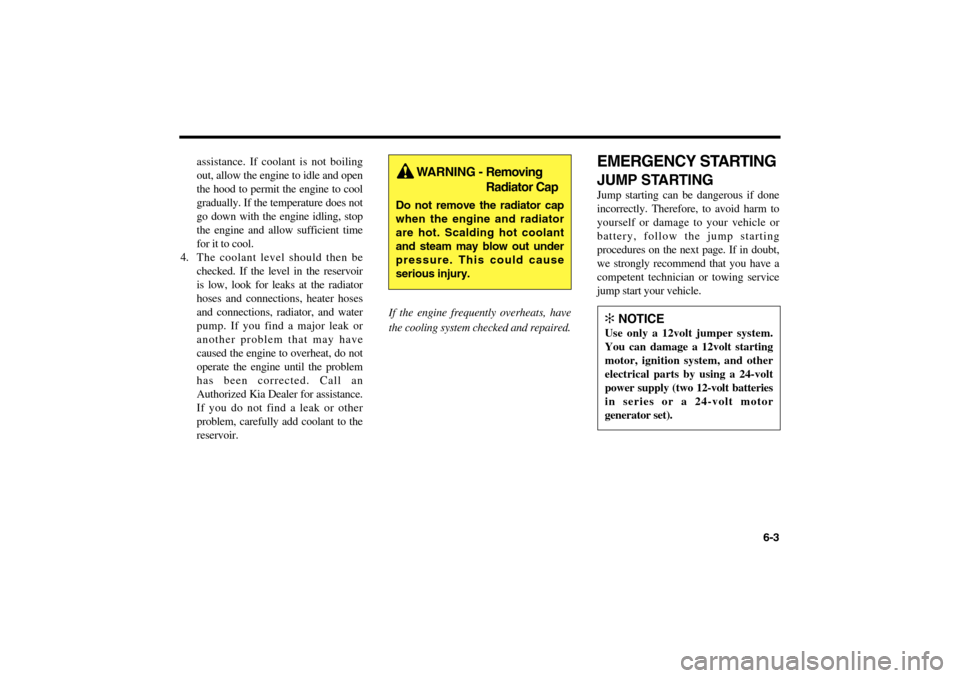
assistance. If coolant is not boiling
out, allow the engine to idle and open
the hood to permit the engine to cool
gradually. If the temperature does not
go down with the engine idling, stop
the engine and allow sufficient time
for it to cool.
4. The coolant level should then be
checked. If the level in the reservoir
is low, look for leaks at the radiator
hoses and connections, heater hoses
and connections, radiator, and water
pump. If you find a major leak or
another problem that may have
caused the engine to overheat, do not
operate the engine until the problem
has been corrected. Call an
Authorized Kia Dealer for assistance.
If you do not find a leak or other
problem, carefully add coolant to the
reservoir.If the engine frequently overheats, have
the cooling system checked and repaired.
EMERGENCY STARTINGJUMP STARTINGJump starting can be dangerous if done
incorrectly. Therefore, to avoid harm to
yourself or damage to your vehicle or
battery, follow the jump starting
procedures on the next page. If in doubt,
we strongly recommend that you have a
competent technician or towing service
jump start your vehicle.
6-3
WARNING - Removing
Radiator Cap
Do not remove the radiator cap
when the engine and radiator
are hot. Scalding hot coolant
and steam may blow out under
pressure. This could cause
serious injury.
✻
NOTICE
Use only a 12volt jumper system.
You can damage a 12volt starting
motor, ignition system, and other
electrical parts by using a 24-volt
power supply (two 12-volt batteries
in series or a 24-volt motor
generator set).
MS-CNA-Eng 6.QXD 7/25/2005 5:13 PM Page 3
Page 155 of 225
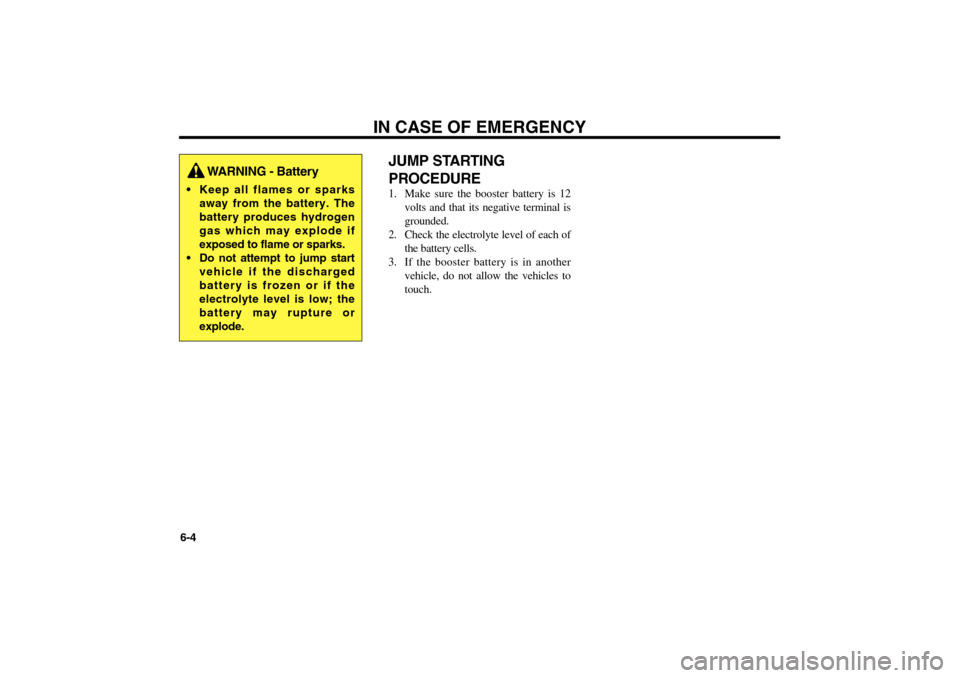
JUMP STARTING
PROCEDURE1. Make sure the booster battery is 12
volts and that its negative terminal is
grounded.
2. Check the electrolyte level of each of
the battery cells.
3. If the booster battery is in another
vehicle, do not allow the vehicles to
touch.
IN CASE OF EMERGENCY
6-4
WARNING - Battery
• Keep all flames or sparks
away from the battery. The
battery produces hydrogen
gas which may explode if
exposed to flame or sparks.
Do not attempt to jump start
vehicle if the discharged
battery is frozen or if the
electrolyte level is low; the
battery may rupture or
explode.
MS-CNA-Eng 6.QXD 7/25/2005 5:13 PM Page 4
Page 158 of 225
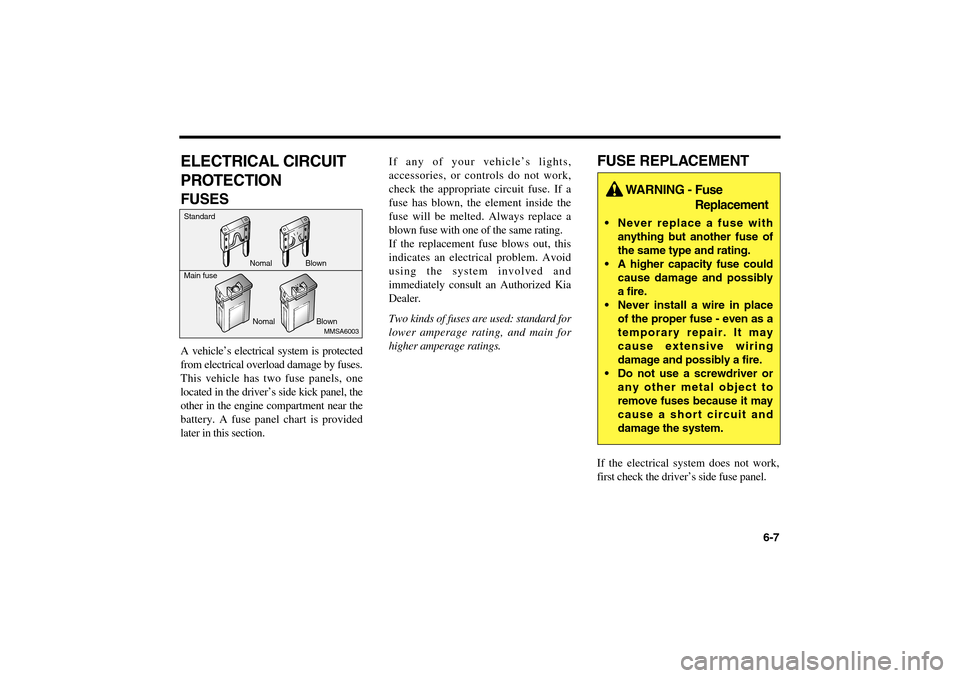
ELECTRICAL CIRCUIT
PROTECTIONFUSESA vehicle’s electrical system is protected
from electrical overload damage by fuses.
This vehicle has two fuse panels, one
located in the driver’s side kick panel, the
other in the engine compartment near the
battery. A fuse panel chart is provided
later in this section.If any of your vehicle’s lights,
accessories, or controls do not work,
check the appropriate circuit fuse. If a
fuse has blown, the element inside the
fuse will be melted. Always replace a
blown fuse with one of the same rating.
If the replacement fuse blows out, this
indicates an electrical problem. Avoid
using the system involved and
immediately consult an Authorized Kia
Dealer.
Two kinds of fuses are used: standard for
lower amperage rating, and main for
higher amperage ratings.
FUSE REPLACEMENTIf the electrical system does not work,
first check the driver’s side fuse panel.
6-7
MMSA6003
Standard
Main fuse
Nomal Blown Nomal Blown
WARNING - Fuse
Replacement
Never replace a fuse with
anything but another fuse of
the same type and rating.
A higher capacity fuse could
cause damage and possibly
a fire.
Never install a wire in place
of the proper fuse - even as a
temporary repair. It may
cause extensive wiring
damage and possibly a fire.
Do not use a screwdriver or
any other metal object to
remove fuses because it may
cause a short circuit and
damage the system.
MS-CNA-Eng 6.QXD 7/25/2005 5:13 PM Page 7
Page 162 of 225

6-11
CLUSTER10A Cluster
START10A Engine switch
SP115A Spare fuse
FRT HTD15A Window defroster
P/SEAT (PASS)25A Power Seat
SP415A Spare fuse
D/CLOCK10A Digtal clock
TAIL(LH)10A Position lights, License plate lights, Tail lights
AUDIO10A Audio
WIPER20A Wiper
ROOM LP10A Dome lights, Front door edge warning lights
TAIL(RH)10A Position lights, License plate lights, Tail lights
C/LIGHTER15A Cigar lighter
EPS10A -
MS-CNA-Eng 6.QXD 7/25/2005 5:13 PM Page 11